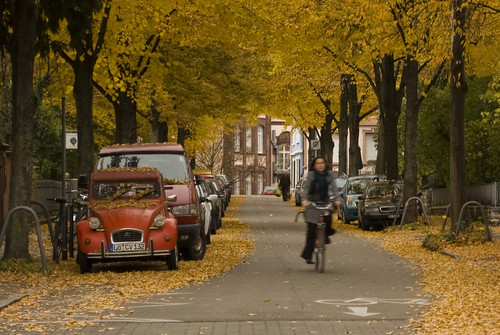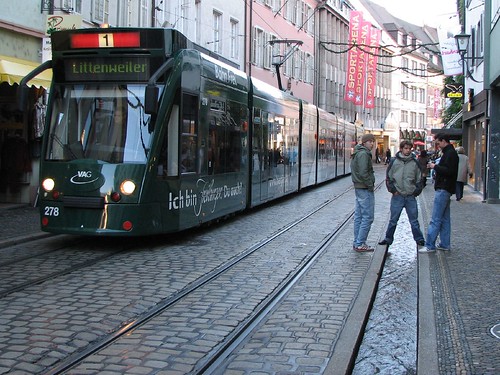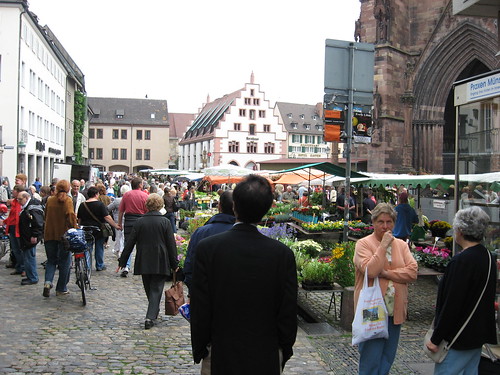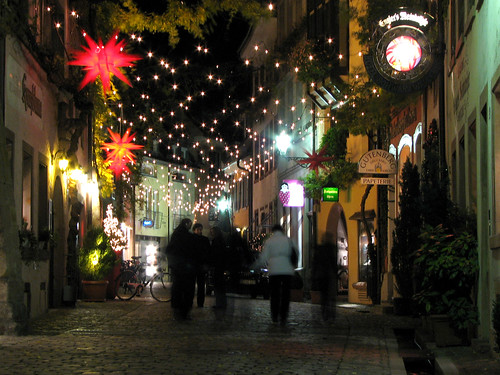I recently came across an interesting article by Ralph Buehler and John Pucher about the city of Freiburg, Germanyand its transportation system and planning since WWII (when it was 80% destroyed by Allied bombing raids). The city isn’t so different from Boulder, Colorado, but it’s a lot further down the path to sustainability than we are. In fact, their transportation mode split today is roughly what Boulder has laid out as our long-term goal in our Transportation Master Plan: less than 1/3 of all trips are made in cars. Fully half of trips are done under human power (23% walking, 27% biking), with another 18% via the city’s 4 tram lines and many feeder buses. The transit system covers 90% of its operating costs from the fare-box, with most people buying monthly flat-rate unlimited use passes for around $50. Around 2/3 of all citizens and all jobs are located within a 3 minute walk from a tram line, and the trams run ~every 5 minutes during peak hours. Households in the US spend about $8000/year on transportation, or $2700 more per year than Germans do, and it ends up being a higher proportion of our overall household expenditures (19% vs. 14%). You might think that that’s just because the government is spending more on their behalf, but actually their total governmental spending is also lower—$460/year vs. our $640/year. All this, and Freiburg’s per capita transportation GHG emissions are only 29% of the US average. So the idea that a high-quality, low-carbon transportation system has to be expensive is a myth.
The city itself has a population of about 230,000 (a bit more than double that of Boulder), and an area of 153 sq km (vs. our 65 sq km), giving the two cities almost identical overall population densities (1,500 ppl/sq km). However, that’s a bit deceptive, since 46% of Freiburg’s territory is actually forest preserves and other conservation areas (they’ve got a very robust open space program) meaning that their actual population density is more like 2,800 ppl/sq km—close to double Boulder’s density. This is still far below Big City density, and there are plenty of quiet residential neighborhoods. In fact, as of 2008, more than 90% of residents lived in traffic calmed areas with speed limits of 30 km/hr (19 mph), and a further 177 neighborhoods had by petition become “home zones” where cars can go no faster than walking speed, and children are able to safely play in the streets at any time. One result is that Freiburg’s traffic fatality rate is about a quarter that of the US (and half that of Germany).
So how did they get to this place? In 1948, the city decided to re-build along the lines of its medieval roots, but by their first land-use plan in 1955 they’d shifted toward auto-centric development priorities, with the margins of the city expanding substantially at suburban densities. The oil shocks of the 1970s and the galvanization of the green movement by plans to build a nuclear power station nearby spurred them to change direction, and the second auto-centric land-use plan, developed in the mid-1960s, was never implemented. Instead, they renovated their light-rail lines and began expanding them, started creating a connected network of bicycle paths, and directed growth and development to take place along the public transit network corridors, ensuring that such developments were mixed use. The city’s land-use plan today identifies 30 neighborhood commercial centers, supporting small retail businesses within easy walking distance of most people. They call it a “city of short distances.” The city center is off-limits to cars, with parking garages at the margins. Meanwhile, the city’s population has grown faster than the region’s, and its economy has grown faster than Germany’s as a whole on a per-capita basis.
 Freiburg has used both carrots and sticks—to make biking and walking and transit attractive, while removing structural incentives that encourage people to drive, like free parking and large socialized investments in road infrastructure. The result has been that their transportation system is cheaper, safer, more equitable and much more sustainable than ours. We should try and learn from them.
Freiburg has used both carrots and sticks—to make biking and walking and transit attractive, while removing structural incentives that encourage people to drive, like free parking and large socialized investments in road infrastructure. The result has been that their transportation system is cheaper, safer, more equitable and much more sustainable than ours. We should try and learn from them.
Further reading:
- Sustainable Transport in Freiburg, by Ralph Buehler and John Pucher at Virginia Tech. The paper that got me started on all this.
- Freiburg: City of Vision, an overview of the city’s urban policies, including land use planning and transportation.
- Freiburg Green City, a bunch of information about the Vauban neighborhood’s many sustainability measures, from the 2010 Expo in Shanghai, China.
- An overview of Freiburg’s broader sustainability policies from Eco Tipping Points.







 (5 votes, average: 4.20 out of 5)
(5 votes, average: 4.20 out of 5)